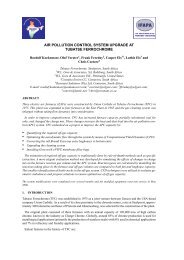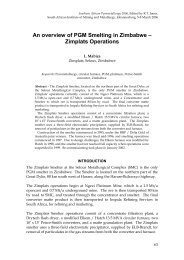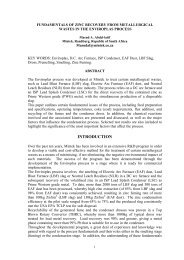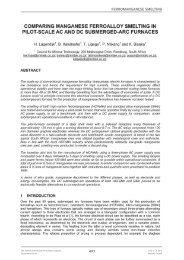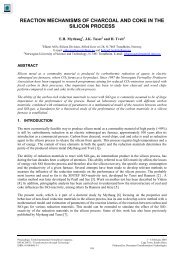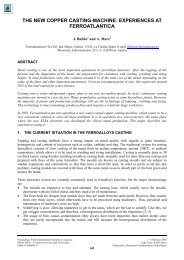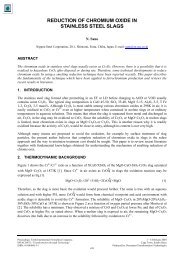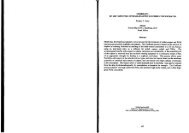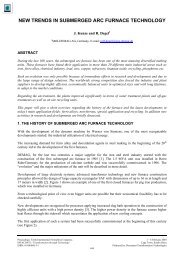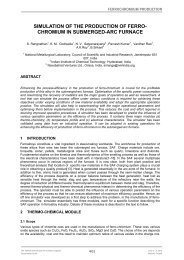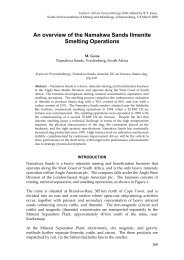ferro alloy design, ferro alloy selection and utilisation ... - Pyro.co.za
ferro alloy design, ferro alloy selection and utilisation ... - Pyro.co.za
ferro alloy design, ferro alloy selection and utilisation ... - Pyro.co.za
- No tags were found...
Create successful ePaper yourself
Turn your PDF publications into a flip-book with our unique Google optimized e-Paper software.
Applications <strong>and</strong> UsesFrom the table 2 scenarios the main <strong>co</strong>nclusions are:• To refine the steel as fast as possible <strong>and</strong> to minimize treatment <strong>co</strong>sts, low carbonscrap additions should be maximized late in the process after the decarburisation.• In cases where much energy is available, scrap additions during decarburi<strong>za</strong>tiondecreases treatment time.• When little energy is available, scrap additions during decarburi<strong>za</strong>tion increasestreatment time.• The influence on process time on a 100 t heat by selecting where to put specificadditions is in the order of 1 minute per ton of addition.• With a <strong>co</strong>st difference of 4-5 Euro/produced ton, the influence on <strong>co</strong>st per ton ofproduced unit by selecting where to put an addition is in the order of 1 euro per ton ofaddition.Thus, the difference between the best or worst decision on when to make an addition <strong>co</strong>uld be up to10 minutes in process time <strong>and</strong> 1000 Euros in total <strong>co</strong>st.Table 2:9-13 ton of neutral scrap added in different process situations to demonstrate influence of<strong>co</strong>nverter additions <strong>and</strong> importance of optimizing when to make an addition.In table 3, simulations were made where two tons of <strong>alloy</strong>s, added at different times, were allowed tosubstitute the same amount of neutral scrap.From the table 3 scenarios the following <strong>co</strong>nclusions aredrawn:• The influence on process time on 100 t heat by selecting different addition order is inthe order of 1 minute per ton of addition.• Less Si <strong>and</strong> C clearly give a faster process.• High C <strong>and</strong> Si additions give less time influence early in the process <strong>and</strong> there arerestrictions on using them late in the process.• Cr should be added late in the process <strong>and</strong> Nickel early when this is possible<strong>co</strong>nsidering other <strong>alloy</strong> properties.• There are restrictions on high carbon raw materials in terms of their use late in theprocess that makes them less attractive than low carbon alternatives.• The production <strong>co</strong>st difference by selecting when to use specific <strong>alloy</strong> in the process isin the order of 1 euro per ton of addition.• The production <strong>co</strong>st difference by selecting what <strong>alloy</strong>ing to do in the <strong>co</strong>nverter is in theorder of 1 euro per ton of addition.The Twelfth International Ferro<strong>alloy</strong>s CongressSustainable Future926June 6 – 9, 2010Helsinki, Finl<strong>and</strong>



